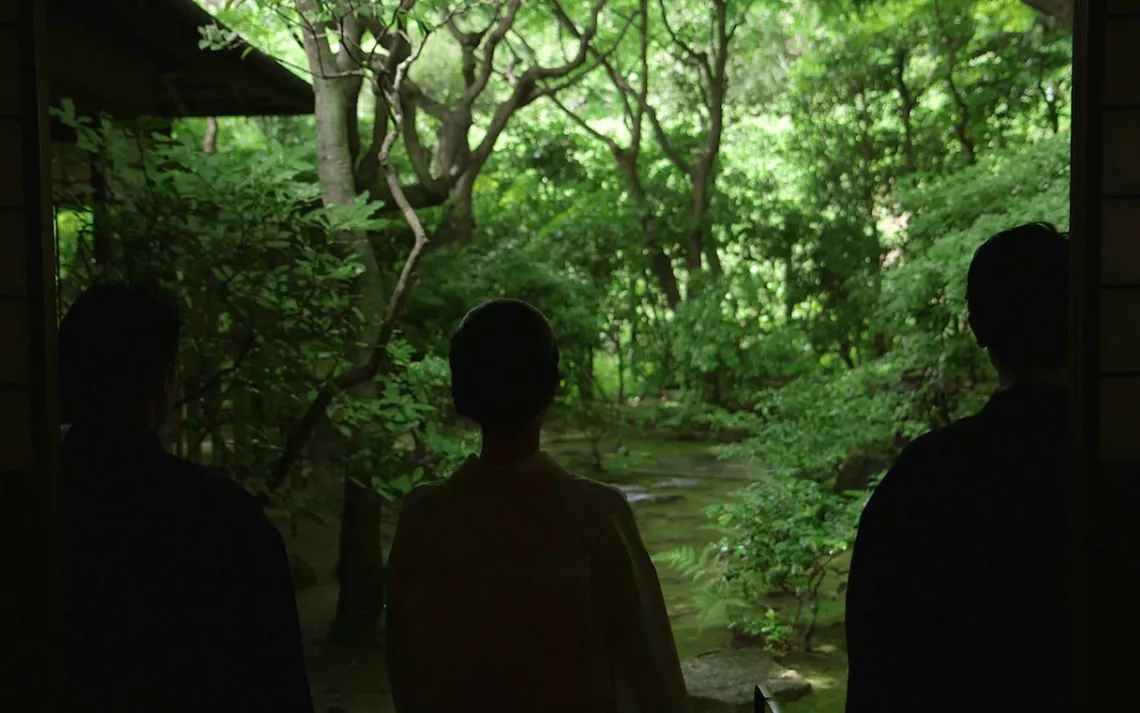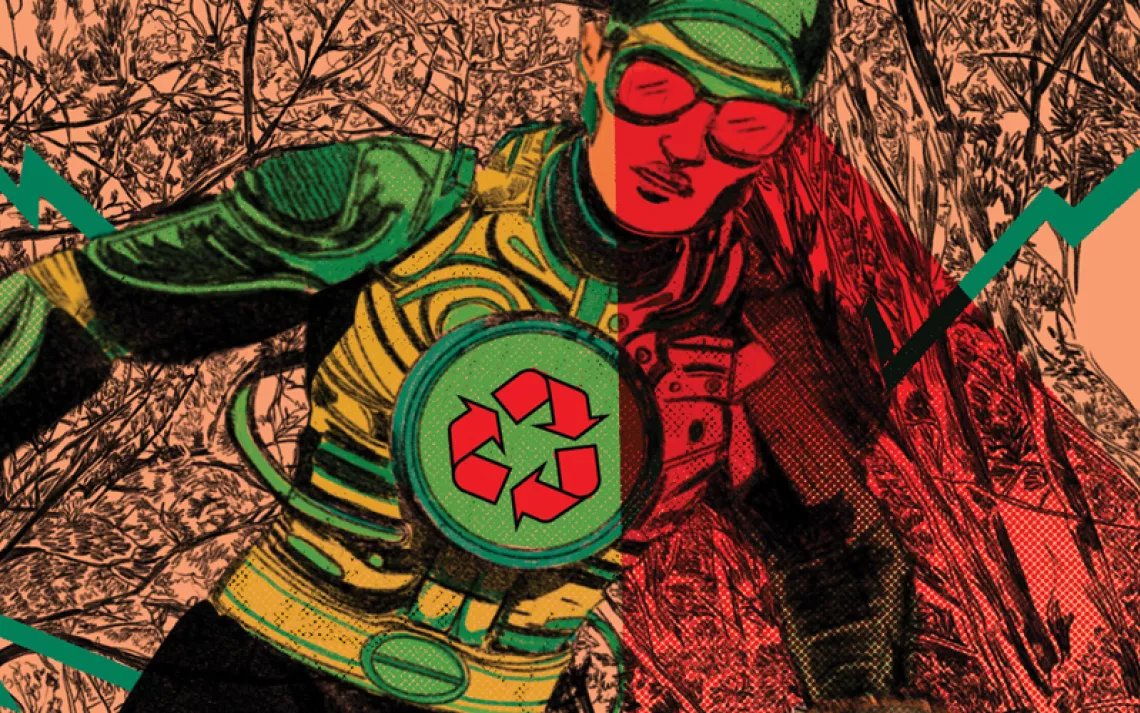A Quiet Passion
The creators of "In Pursuit of Silence" get vocal about quietude

Photo courtesy of In Pursuit of Silence
“There is much to learn by those who understand the language of the great silent places,” said Harry Karstens, Denali National Park’s first superintendent, in 1924. That same belief drove filmmakers Patrick Shen and Brandon Vedder to launch a Kickstarter campaign in 2013 with the hope of exploring humans’ relationship to silence, noise, and the natural world. The result? In Pursuit of Silence, a visually luminous documentary coming to select U.S. cities in June.
The film takes viewers into Japanese tea houses, cacophonous subway stations, soundless audio chambers, and federally protected landscapes to explore the effects of silence on the body, mind, and psyche. To illustrate how much louder the world has become since Karstens’s time, the film documents the constant bombardment of chatter wrought by our increasingly technology-dependent lifestyles. The result is a seemingly inescapable envelopment into noise—a form of pollution that the World Health Organization describes as an environmental burden second only to air pollution.
Along the journey, Shen and Vedder meet with sonic theorists, National Park Service soundscape technicians, environmentalists, shamans, scientists, and even a college student honoring a vow of silence while walking across the United States. The film’s many examples, including the pioneering work of John Cage—avant-garde composer of a controversial “silent symphony”—lay out various paths for recalibrating one’s relationship with internal and external sound.
This film had a tremendous effect on director Shen, who today works from a Thoreauvian shack, and on co-producer/co-cinematographer Vedder, who can now say he’s been to a “Noise-Con.” Sierra tracked down the filmmakers to find out how they forged such a compelling story out of such a broad concept, and why they believe that the pursuit of silence—even if just for a few minutes each day—helps us better understand our place in the world.
Sierra: What got you interested in exploring this topic?
Shen: We had various reasons, but for me, what planted the seed was seeing a film called Into Great Silence. It’s a three-hour meditative documentary about monks in the French Alps. I’d been thinking a lot about silence beforehand, but couldn’t quite articulate what it really was until I saw this film—that’s the first time I thought about silence as an entity into itself. As I delved deeper, I discovered the writings of John Cage, and of Nathaniel Dorsky, a filmmaker who makes all-silent films. He gave us a language to use—or at least a way to kind of get into the subject matter, cinematically speaking.
Vedder: We got a grant from the Center for Asian American Media to go spend some time with Nathaniel at his house in San Francisco and use him as a resource. He helped us make hard decisions about how to construct our story, and what to take out. We had a lot of conversations about cinema, and about the role of silence in cinema—Nathaniel works at this level where he respects the silence between the notes just as much as the notes themselves.
At what point did it become an environmental project?
Shen: The moment I discovered all the WHO [World Health Organization] research into noise pollution and saw how severe of a problem it is was when the framework for the film really surfaced. Initially, we had a real fascination with silence, and with finding a way to tell its story cinematically, but I didn’t have a vision for how to flush out an entire film about the subject. So we decided to focus on how the experience of quiet was becoming more and more threatened. We also talked to field recordists who regularly go out and capture hours of wild sound, and learned that nowadays, they can get maybe five to 10 minutes of silence—and that’s on a good day—and realized there was a real story here. Silence is something that speaks to our internal lives, but of course there are also really external, practical things we need to start thinking about if we’re going to survive and thrive as humans. The noise level of daily life has just gotten ridiculous—it’s at a fever pitch, especially if we’re taking into account the digital white noise, the fake news, this whole glut of stuff.
Vedder: As documentary filmmakers trying to find funding, we didn’t have the luxury of doing six months of prep and research—we just had to learn more about silence as we went. But the more we started talking about the noise pollution issue, the more stories we uncovered about individuals pursuing silence in their own unique ways.
You shine a close light on the intersection of silence and nature, highlighting how both are beneficial, perhaps even crucial, to our health. At what point did nature become such a major component of the film?
Shen: The literature is clear that silence (as in “zero decibels”) doesn’t actually exist in nature—and that nor would we want that. One of the first things I googled was “quietest place on Earth,” which is Orfield Laboratories, a soundless chamber in Minneapolis. I read all these stories about people who spend time in silent chambers and end up driving themselves crazy—their blood even starts to flow faster. So, we knew the conversation we wanted to start wasn’t about zero-decibel silence, but rather about the types of sound that do give us that sense of peace and quiet. And when we have that kind quiet in our lives, it’s often amidst some sort of natural environment. So, we intuitively understood that nature would be part of the conversation; we just didn’t know what conversations we’d have within that relationship.
I loved all the stunning nature panoramas. How did you scout your filming locations?
Vedder: We didn’t have the luxury, budget- and time-wise, to do a lot of formal scouting [laughs]. We did a lot of Google Earth research. It was pretty scattershot—our first research trip was to Denver, for a noise-abatement convention: the Noise and Vibration Conference and Exhibition, also known as “Noise-Con.” It’s a gathering of engineers and others seeking ways to fix the noise coming from our appliances, our machinery. We had lunch there with the guy who’s the noise engineer for Harley Davidson, and talked to him about what it looks like to try to engineer one of the loudest and most invasive sounds we have today. Patrick [Shen] jumped on the back of a Harley for this event called “Thunder In the Rockies”—it’s this super-loud gathering of bikers who meet in Loveland, Colorado, to tear through this specific [mountain] pass at ridiculous levels of noise. After that, we went to Fort Collins to meet with Kurt Fristrup, who’s with the NPS Natural Sounds and Night Skies Division. They measure the impact of noise and light pollution, and engineer ways to safeguard natural sounds and darkness, and try to get park visitors to appreciate wild soundscapes and starry skies. That’s what triggered us bouncing around the country, visiting birders and naturalists and eventually raising money to go to Japan and experience forest bathing and tea gardens.
What surprised you most during the filmmaking process?
Vedder: Meeting Dr. [Yoshifumi] Miyazaki in Japan. He commissioned and designated 60 forest-therapy locations and did a study of the acoustic levels at Shibuya Crossing, a crosswalk in Tokyo that’s rumored to be the busiest intersection in the world—something like half a million people cross through in a day. He had his subjects hooked up to EKG and brain scan mechanisms to monitor the incredible differences between the energy we expend when we’re filtering out that kind of noise—it literally sucks the energy right out of you. He showed us these simple graphs that were incredibly dramatic in depicting how much of our bodily processes are devoted to dealing with that noise, compared to graphs of the energy expenditures of bodies in a forest setting.
Shen: Mine was the experience of going to Minnesota, into the anechoic chamber known as the quietest place in the world. I grew up playing in bands, and I had a hunch I’d probably damaged my hearing, but it wasn’t until I walked into those 99-percent soundproof chambers that I realized I had tinnitus, because I heard constant ringing. Once I was able to start filtering that out and settle in, I had all these thoughts running through my brain. Learning how noisy my own mind is every waking moment of the day, was really a revelation. Not until that white noise of the world fell away did I realize how much work I had to do to really chill out and calm my mind.
How did the process of making this film alter your own relationship with silence?
Shen: About a year into the project, I made the decision to stop going into an office space in a busy area of Los Angeles and built a small shed in my backyard where I retreat five days a week to do my work in silence and solitude. The idea was to fuse silence into my everyday [life], rather than just seek out little moments here and there. Because in many religious traditions, particularly Zen Buddhism, you have monks who see no delineation between silence and daily activity. It’s changed how I approach not just work but my entire life. It’s still a work in progress, but it’s set me down a path of finding a way for my work and life to not just be these things outside of my exploration of silence, but to have them be one and the same. I’m hoping that my work as an artist will have a very different quality from here on out—a reflection of this new dynamic.
Vedder: It’s not just a coincidence that my family moved out of L.A. in the midst of making this film. It’s something we’d already been talking about, but as I tuned in and became more and more aware of my sonic environment and how it affects me on a daily basis—how much energy filtering noise out was consuming—I realized how integral what we hear is to how we live our lives and make our decisions. Pico Iyer, who’s featured in the film, wrote that our lives are like a big canvas, and we’re standing just an inch away from it. One thing silence does is it allows us to take that step back, to take it all in. It’s so hard to do that, but it helps us understand what we believe about the world, and what it is we want to contribute.
So you each significantly changed your lives. What are you hoping viewers take away from the film?
Shen: We understood from the beginning that making a documentary about silence was kind of a fool’s mission. We were careful not to set out to demystify and define it, but instead tried to touch upon things related to silence. For example, in the film, we didn’t talk about meditation as a solution or as a way in. We tried to stay away from those prescriptive sorts of things and to make the film more of an invitation to explore silence further, to understand its potential.
Vedder: We wanted it to be not just about silence but very much of silence—to offer a dose that would help people understand silence not just with their intellect, but with their entire being. We hope it serves as an invitation to explore silence further, in whatever context.
 The Magazine of The Sierra Club
The Magazine of The Sierra Club







